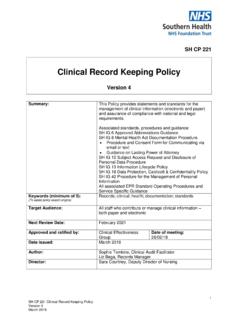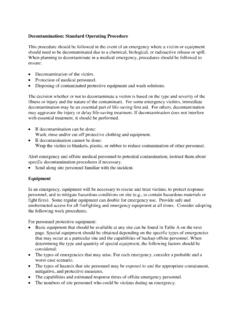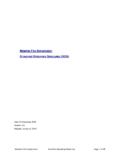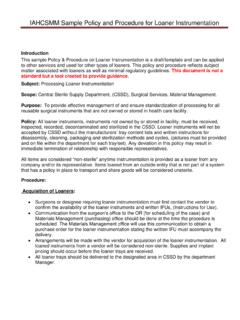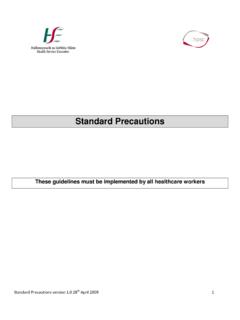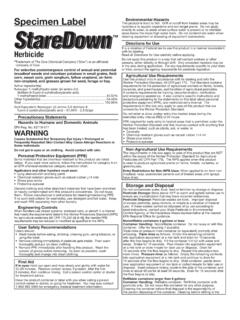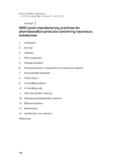Transcription of Aseptic Technique and Clean Technique Procedure
1 1 SH CP 13 Aseptic and Clean Technique Procedure Version: 4 November 2018 SH CP 13 Aseptic Technique and Clean Technique Procedure (Infection Prevention & Control policy: Appendix 7) This Appendix must be read in conjunction with the Infection Prevention and Control Policy Version: 4 Summary: Provide a standardised approach to Aseptic Technique and clear indication where a standard Aseptic Technique is required and when Clean Technique is indicated Keywords (minimum of 5): (To assist policy search engine) Aseptic , Technique , Clean , non-touch, standardised Target Audience: All staff of all disciplines, Non-Executive Directors, Volunteers, Governors and Contractors Next Review Date: November 2022 Approved & Ratified by: IP&C Group Date of meeting: Date issued: November 2018 Author: Jacky Hunt, Nurse Infection Prevention & Control (North) Accountable Executive Lead: Paula Hull, Director of Nursing and Allied Health Professionals 2 SH CP 13 Aseptic and Clean Technique Procedure Version.
2 4 November 2018 Version Control Change Record Date Author Version Page Reason for Change Jacky Hunt 1 New policy Jacky Hunt 2 Reference to ANTT removed Jacky Hunt 3 More detail on Clean Technique added Jacky Hunt 3 Appendix and amended as well as when to wear an apron for certain IV procedures , following clinical visits by IPC Team Jacky Hunt 4 Periodic review date reached Reviewers/contributors Name Position Version Reviewed & Date IP&C Team V2 Sue Benzie V2 Steve Coopey V2 Area Matrons V2 Julie Parsons V2 Sue Hobbs V2 Lyn Aldridge V2 Louise Marshall V2 Louise Felice V2 Jude Diggins V2 on IPC Committee Policy Consultation Group V2 IPC Team Caryn Carr Lead Tissue Viability Nurse Specialist IPC Group (for IPC Gp )
3 Policy Consultation Group Caryn Carr Lead Tissue Viability Nurse Specialist V3 IPC Team V3 Caryn Carr Lead Tissue Viability Nurse Specialist V4 IPC Team V4 Sharon Guy Lead Clinical Educator V4 3 SH CP 13 Aseptic and Clean Technique Procedure Version: 4 November 2018 Contents Page 1. Introduction 4 2. Definitions 4 3. Process the basic principles of Aseptic Technique 8 4. Applying the principles of Aseptic Technique 11 5. Principles of Clean Technique 14 6. Indications table 15 7. Training 18 8. Supporting references Appendices 19 Aseptic Technique clinical competency 20 Best practice statement for performing a dressing in a home environment 26 Best practice statement for performing a dressing in a clinic environment 31 Generic treatment room standard 36 Skin preparation 41 4 SH CP 13 Aseptic and Clean Technique Procedure Version: 4 November 2018 Aseptic Technique and Clean Technique Procedure 1.
4 Introduction The purpose of this appendix is to: Provide a standardised approach to Aseptic Technique (AT) and clear indication where asepsis is required and when Clean Technique is indicated. Ensure the principles of asepsis are observed during any invasive Procedure that bypasses the body s natural defences skin or mucous membrane Ensure compliance with The Health and Social Care Act (Dept. of Health 2015). Give formal guidance to staff and their managers as to when competence has been achieved in Aseptic Technique (AT). Please note that surgical Aseptic Technique , eg as in an operating theatre, is beyond the scope of this document.
5 2. Definitions Asepsis - is recognised as the state of being free from pathogenic (harmful) microorganisms Aseptic Technique (AT) - is defined as a means of preventing or minimising the risk of introducing harmful micro-organisms onto key parts or key sites of the body when undertaking clinical procedures . Sterile gloves are not always required for AT. Each Procedure must be risk assessed. Whether sterile or non-sterile gloves are worn depends if you can avoid touching the sterile parts of equipment which will come into contact with other susceptible sites or parts their wound/cannula/catheter connection. If the Procedure is complex or the patient is particularly immuno-compromised, sterile gloves must be worn.
6 If however you can carry out the Procedure without touching the key part with your hands, non-sterile Clean gloves may be worn (See Section 6 of this Appendix Indications Table as a guide). These methods have been developed to ensure that only uncontaminated objects/fluids make contact with key parts or key sites Aseptic Technique is traditionally segregated into surgical Aseptic Technique and Aseptic Technique : Risk reduction of contamination Clean Technique Surgical Aseptic Technique (AT) Asepsis Aseptic Technique (AT) 5 SH CP 13 Aseptic and Clean Technique Procedure Version: 4 November 2018 Aseptic field an Aseptic field is an area created to control the environment around the Procedure and protect the key parts and key sites.
7 Often this can be achieved by placing a sterile towel/s around the Procedure site and on the surface that will hold sterile instruments and other items such as dressings. Clean Technique is a non-touch Technique . It is defined as a modified Aseptic Technique used for certain procedures that acknowledges the use of some non-sterile items/fluids but aims to reduce the risk of contamination by pathogenic (harmful) micro-organisms eg chronic leg ulcer care. Clean surface wiped surface wiped with Clinell sanitising wipe, to make free from dust and soil. Cleaning is an important action in removing dirt to help achieve asepsis. Healing by secondary intention refers to healing of an open wound from the base upwards but is not necessarily a cavity wound or sinus.
8 Key site - an area belonging to the patient where harmful organisms can enter the body and cause infection eg wounds, urinary tract, cannula insertion site. Key parts - refers to the key sterile equipment parts. These key parts are the pieces of equipment that are manufactured sterile and would be in direct contact with the key sites of the patient or other key parts. They have the potential to transmit harmful microorganisms if they become contaminated. Key parts must be protected from contamination. Any key part must only come into contact with other key parts ( sterile syringe tip and needle hub). Non-key parts can be gripped firmly.
9 The aim is to prevent contamination of a key part by not touching it. If this is not possible the use of sterile gloves allows the staff member to touch a key part. For examples of key equipment parts relevant to intravenous therapy, urinary catheterisation and wound care please see pages 6 & 7. 6 SH CP 13 Aseptic and Clean Technique Procedure Version: 4 November 2018 Examples of key equipment parts relevant to Intravenous therapy: Syringe needle Syringe needle hub Drug itself Neck of vial/ampoule Syringe tip Drug itself Injectable bung Giving Set Spike Internal neck/connection point of intravenous fluid bag Infusate fluid Sterile part of the dressing in direct contact with the cannula insertion site Examples of key equipment parts relevant to urinary catheterisation therapy 7 SH CP 13 Aseptic and Clean Technique Procedure Version.
10 4 November 2018 Examples of key equipment parts relevant to wound care Dressing in direct contact with wound Forceps tips or gauze swabs which will be in contact with the wound Sterile Saline Sterile galipot for holding infusate THIS IS NOT AN EXHAUSTIVE LIST of KEY PARTS Pathogenic microorganism a microorganism that is capable of causing harm. See asepsis definition. Sterile - free from micro-organisms. Once a sterile pack has been opened, the contents are no longer considered sterile. Surgical Aseptic Technique - Surgical Aseptic Technique is a strict process and includes procedures to eliminate micro-organisms from an area. It is practiced by health care workers in operating theatres and some dedicated minor operation areas.


